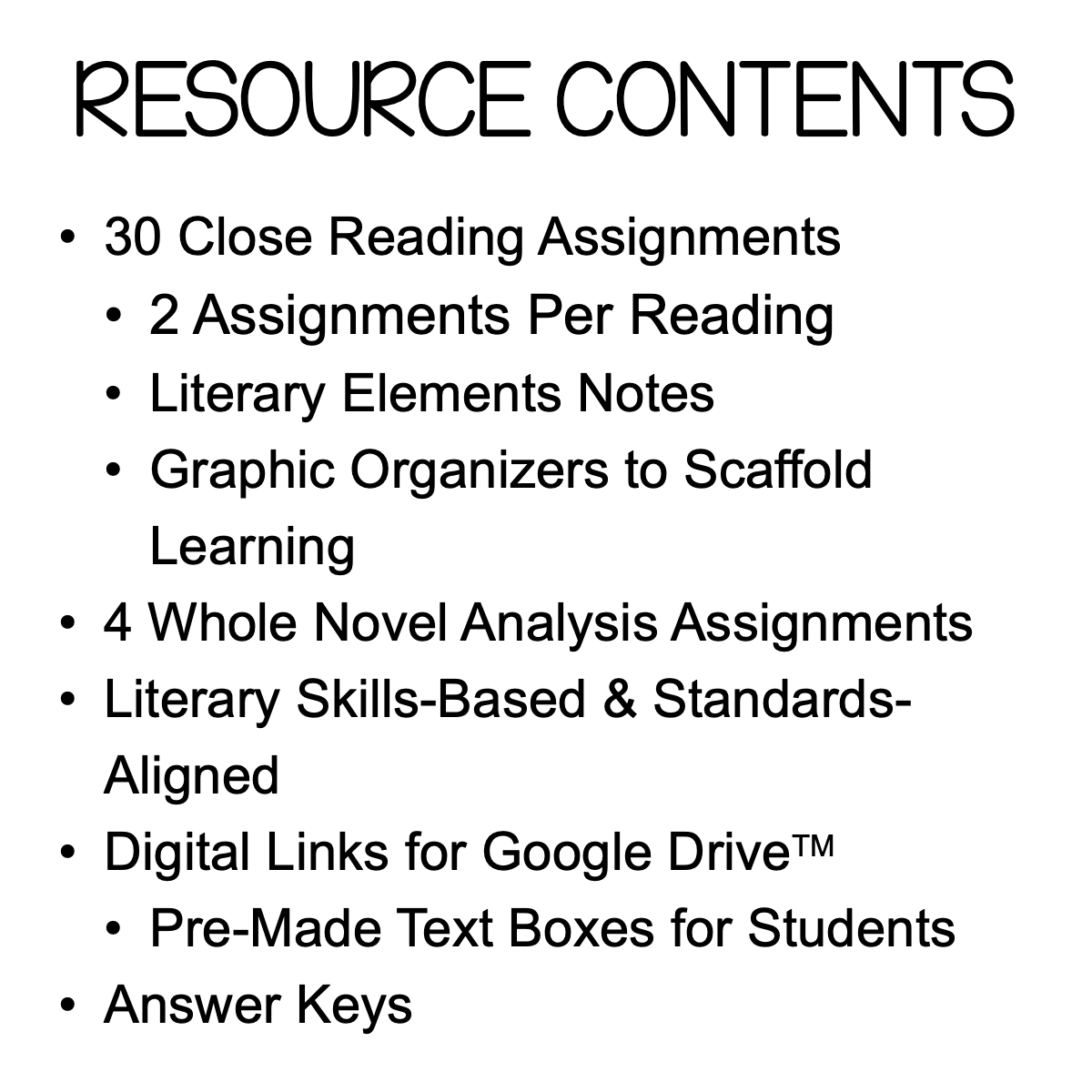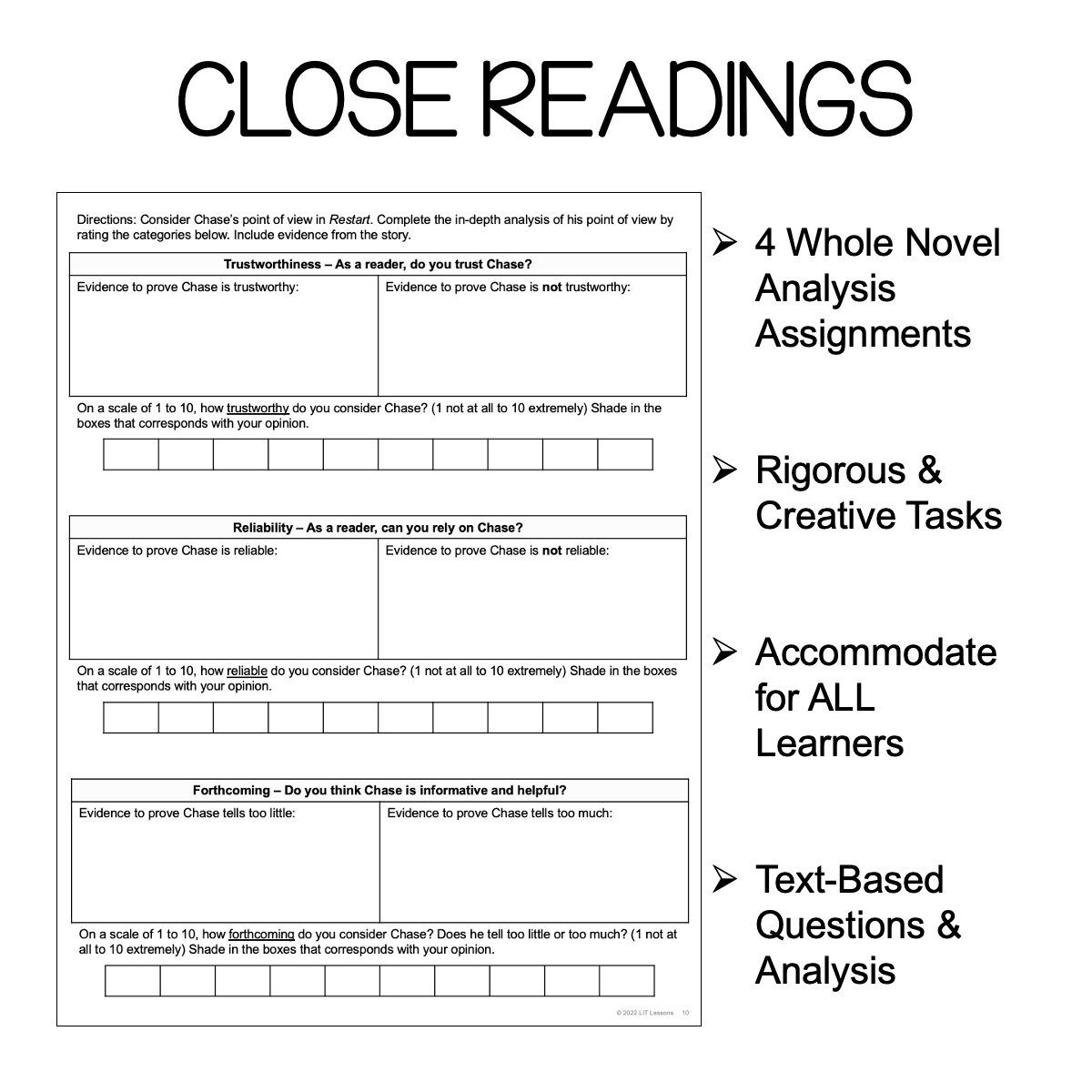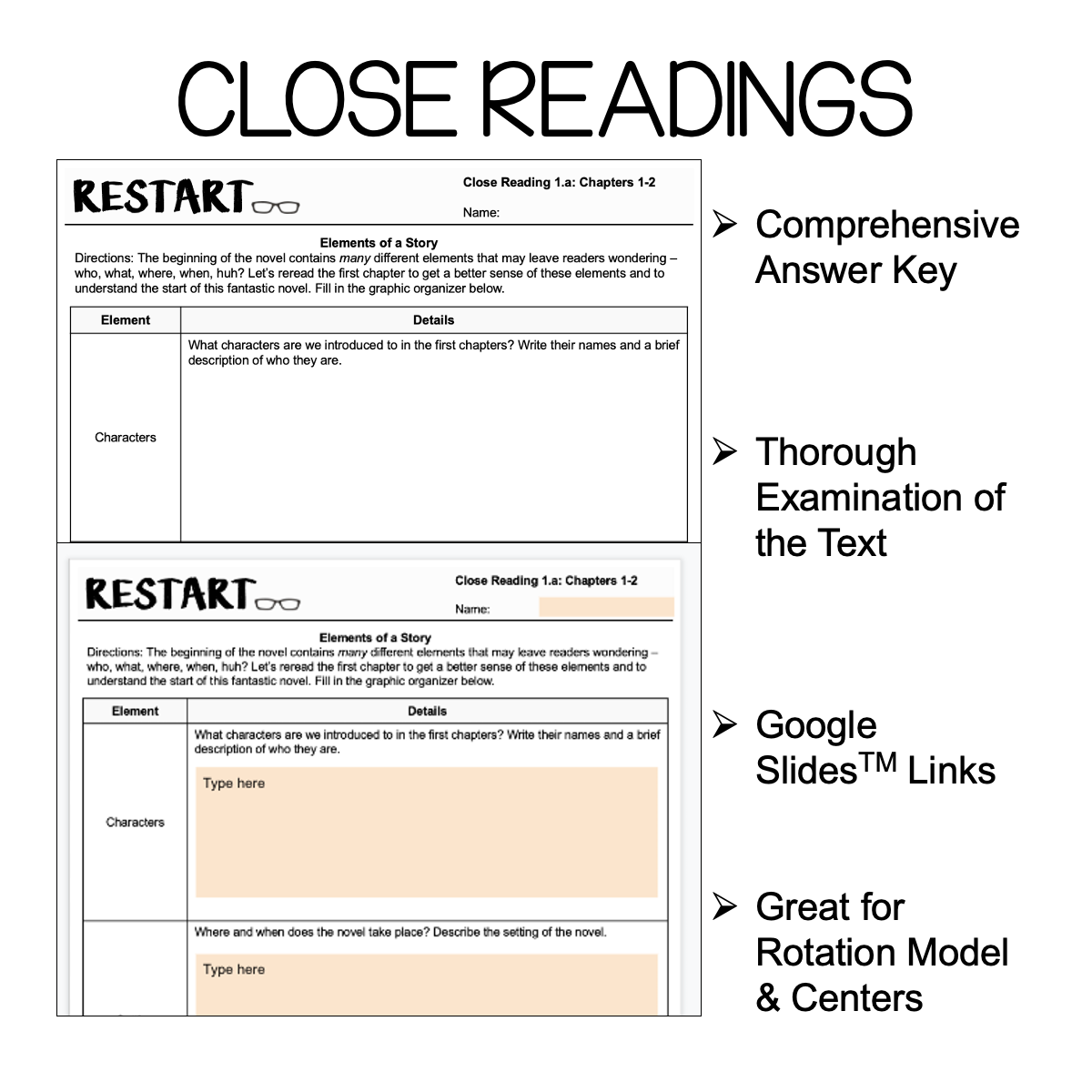Restart by Gordon Korman Close Readings
You can only add to a wishlist if you have an account, please register now.
Create an Account$8
Restart Close Readings – Snapshot of Included Resources:
- 30 Close Reading Assignments
- 2 Assignments Per Reading
- Literary Elements Notes
- Graphic Organizers to Scaffold Learning
- 4 Whole Novel Analysis Assignments
- Literary Skills-Based & Standards-Aligned
- Digital Links for Google Slides™
- Pre-Made Text Boxes for Students
- Answer Keys
-
Analysis of point of view of the text
-
Author’s use of word choice to develop tone and mood
-
Analysis of flashbacks
-
Analysis of conflict and plot
-
Identifying and analyzing setting for mood and conflict
-
Character analysis
-
Development of motif and theme across the novel
-
Figurative language and symbolism analysis
- ZIP file (PDFs and Word Docs for Digital Links)
- Non-Editable
- 3.88 MB
- 126 Pages
- Links for Student Pages in Google Slides™
- This downloadable resource supplies one single-teacher license for use in your classroom.
- Photocopying of this product is allowed only for the classroom use of the purchaser.
- Replication of this product, in whole or in part, for commercial sale or broader distribution is strictly prohibited.
- This product also may NOT be shared electronically, digitally, or otherwise in a manner that violates the Terms of Use detailed by LIT Lessons.
- For explicit information on permissions, please see the Terms of Use document included with this resource. Thank you for your cooperation and understanding.
Restart Close Readings – Snapshot of Included Resources:
- 30 Close Reading Assignments
- 2 Assignments Per Reading
- Literary Elements Notes
- Graphic Organizers to Scaffold Learning
- 4 Whole Novel Analysis Assignments
- Literary Skills-Based & Standards-Aligned
- Digital Links for Google Slides™
- Pre-Made Text Boxes for Students
- Answer Keys
-
Analysis of point of view of the text
-
Author’s use of word choice to develop tone and mood
-
Analysis of flashbacks
-
Analysis of conflict and plot
-
Identifying and analyzing setting for mood and conflict
-
Character analysis
-
Development of motif and theme across the novel
-
Figurative language and symbolism analysis
- ZIP file (PDFs and Word Docs for Digital Links)
- Non-Editable
- 3.88 MB
- 126 Pages
- Links for Student Pages in Google Slides™
- This downloadable resource supplies one single-teacher license for use in your classroom.
- Photocopying of this product is allowed only for the classroom use of the purchaser.
- Replication of this product, in whole or in part, for commercial sale or broader distribution is strictly prohibited.
- This product also may NOT be shared electronically, digitally, or otherwise in a manner that violates the Terms of Use detailed by LIT Lessons.
- For explicit information on permissions, please see the Terms of Use document included with this resource. Thank you for your cooperation and understanding.



More Restart Resources...
Restart Novel Study
The Restart Novel Study is a comprehensive novel study for teaching Restart by Gordon Korman. This novel study provides unique opportunities to implement an engaging exploration of this popular book. Whether you have taught Restart for years or it is your first time, the Restart Novel Study will provide you with the resources you need to teach a successful and thoughtful unit.
Restart Chapter Questions
The 30 comprehension and literary analysis resources for Restart will give students repeated opportunities to practice essential literacy skills aligned to the Common Core State Standards. For every two chapters, students will have to answer rigorous, text-based questions that assess not only their ability to comprehend but also their ability to analyze key events. There are two sets of questions for each reading: Chapter Questions A (comprehension) and Chapter Questions B (analysis). The twin sets offer different levels of challenge for students to give you options for meeting the needs of all your learners. All 30 assignments include questions that require close reading of the text, which means your students will always be practicing essential skills. With numerous options for implementation, the resource also allows for differentiation and can enable accommodation that will meet the needs of all learners.
The discussion questions provide open-ended prompts to deeply explore the themes and conflicts prominent in Restart. The resources include one prompt for every reading (15) and 12 questions for whole novel analysis. The 15 reading discussion questions are provided in two different formats – graphic organizers and task cards – that will allow flexible implementation. The whole novel discussion questions are provided as task cards. Use the questions for independent work, small group or whole class discussion, reflection, homework, or more.
Restart Assessments
The standards-aligned assessments will help you measure your students’ comprehension of Restart and their ability to apply the literary skills taught throughout the unit. The materials include 15 reading checks, 3 novel quizzes, 1 final differentiated test, and an essay choice board.
Restart Informational Texts & Activities
The 5 informational texts, 7 extension activities, and 1 final cross-curricular project will build your students’ knowledge about memory, the brain, amnesia, and the processes involved in memory formation. Students will learn about the brain’s structures, brain plasticity, and the different types of memories that shape our everyday lives. When synthesized with a reading of Restart, the information will prompt critical thinking and analysis about the significance of memory in day-to-day life. By the end of this unit of study, students will have developed their ability to think critically, make connections between texts, and expanded their understanding of the science of memories.
PLEASE NOTE: This Restart resource includes many identical readings and activities in The Giver Novel Study resource. Please DO NOT purchase both. If you are interested in both novel studies, reach out for special discount pricing at lauren@lit-lessons.com. Thank you!
Restart Vocabulary
The vocabulary resources will engage students in varied activities to expand their vocabulary found in Restart. The resources include materials to help teach challenging vocabulary words in Restart that will then build your students’ vocabulary. With 4 vocabulary lists of 10 words each and a crossword puzzle, practice assignment, and quiz for each set, the materials provide opportunities for differentiation to suit the needs of the classroom.

Restart Novel Study
The Restart Novel Study is a comprehensive novel study for teaching Restart by Gordon Korman. This novel study provides unique opportunities to implement an engaging exploration of this popular book. Whether you have taught Restart for years or it is your first time, the Restart Novel Study will provide you with the resources you need to teach a successful and thoughtful unit.

Restart Chapter Questions
The 30 comprehension and literary analysis resources for Restart will give students repeated opportunities to practice essential literacy skills aligned to the Common Core State Standards. For every two chapters, students will have to answer rigorous, text-based questions that assess not only their ability to comprehend but also their ability to analyze key events. There are two sets of questions for each reading: Chapter Questions A (comprehension) and Chapter Questions B (analysis). The twin sets offer different levels of challenge for students to give you options for meeting the needs of all your learners. All 30 assignments include questions that require close reading of the text, which means your students will always be practicing essential skills. With numerous options for implementation, the resource also allows for differentiation and can enable accommodation that will meet the needs of all learners.
The discussion questions provide open-ended prompts to deeply explore the themes and conflicts prominent in Restart. The resources include one prompt for every reading (15) and 12 questions for whole novel analysis. The 15 reading discussion questions are provided in two different formats – graphic organizers and task cards – that will allow flexible implementation. The whole novel discussion questions are provided as task cards. Use the questions for independent work, small group or whole class discussion, reflection, homework, or more.

Restart Assessments
The standards-aligned assessments will help you measure your students’ comprehension of Restart and their ability to apply the literary skills taught throughout the unit. The materials include 15 reading checks, 3 novel quizzes, 1 final differentiated test, and an essay choice board.

Restart Informational Texts & Activities
The 5 informational texts, 7 extension activities, and 1 final cross-curricular project will build your students’ knowledge about memory, the brain, amnesia, and the processes involved in memory formation. Students will learn about the brain’s structures, brain plasticity, and the different types of memories that shape our everyday lives. When synthesized with a reading of Restart, the information will prompt critical thinking and analysis about the significance of memory in day-to-day life. By the end of this unit of study, students will have developed their ability to think critically, make connections between texts, and expanded their understanding of the science of memories.
PLEASE NOTE: This Restart resource includes many identical readings and activities in The Giver Novel Study resource. Please DO NOT purchase both. If you are interested in both novel studies, reach out for special discount pricing at lauren@lit-lessons.com. Thank you!

Restart Vocabulary
The vocabulary resources will engage students in varied activities to expand their vocabulary found in Restart. The resources include materials to help teach challenging vocabulary words in Restart that will then build your students’ vocabulary. With 4 vocabulary lists of 10 words each and a crossword puzzle, practice assignment, and quiz for each set, the materials provide opportunities for differentiation to suit the needs of the classroom.








